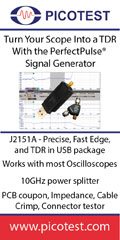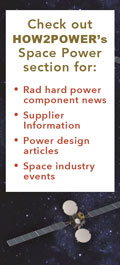 |
|
IN THIS ISSUE:
» The Engineer’s Guide To EMI In DC-DC Converters (Part 9): Spread-Spectrum Modulation
» Versatile SiC JFETs Benefit Power Switching And Circuit Protection Applications
» Advanced Scopes And Probes Help Optimize SMPS Gate Drives For EMC
» New On How2Power.com
» Focus On Magnetics:
Square Vs. Round Core Legs—Balancing Core And Winding Losses
» Spotlight On Safety & Compliance:
Will Your Products Be Ready For Next Wave Of European Efficiency Regulations?
» New Power Products
» Industry Events:
- ECCE 2019 Expo Will Showcase The Latest Tools For Developers Of Power Electronics, Motor Systems And Their Applications
» In Memoriam…
» Other Top Power News
From the Editor's Desk David G. Morrison
Editor, HOW2POWER TODAY

The subject of artificial intelligence (AI) has captured the imagination of the general public, but what exactly will it mean for the power electronics field—beyond making processors more power hungry? Will it speed power supply simulation and design optimization? Will it lead to automation of power supply design tasks or automate customer support for component suppliers serving the industry? Reading this month’s FAE Confidential might suggest that. But mostly there are questions. For those who’d like to explore this topic, an upcoming tutorial on “Artificial Intelligence Applications to Power Electronics,” which will be presented at ECCE 2019, will give engineers a foundation for understanding what’s possible and how it might help address their power electronics challenges. There’s more about ECCE in this issue, in particular a preview of the expo, for those who can make it to Baltimore in September. Meanwhile this August edition of the newsletter, gives you more design techniques to ponder (spread spectrum modulation and oscilloscope capabilities applied to EMI management; the versatility of SiC JFETs, and the impact of magnetic core shapes—square legs versus round). We also bring you a Safety & Compliance column looking at the coming European requirements for energy efficiency, plus the latest power components, test instruments, and more.
|
|
 |
 |

|
HOW2POWER EXCLUSIVE DESIGN ARTICLES 
|
The Engineer’s Guide To EMI In DC-DC Converters (Part 9): Spread-Spectrum Modulation
by Timothy Hegarty, Texas Instruments, Phoenix, Ariz.
For high-frequency switching dc-dc converters, the presence of high slew-rate voltages and currents during switching commutations may generate severe conducted and radiated interference within the regulator itself as well as nearby susceptible circuits. In general, complying with electromagnetic standards is an increasingly important task for switching power supplies, not because of excessive total spectral energy, but more so due to concentrated energy in specific narrow bands at the fundamental switching frequency and its harmonics. Spread-spectrum frequency modulation (SSFM) is a way to distribute spectral energy in the frequency domain and thus flatten the fundamental and harmonic noise peak amplitudes. The spread-spectrum effect is available as an additional and complementary method of noise reduction with respect to the EMI mitigation techniques described in previous installments of this series. Here the author explains the math behind SSFM and details of its practical implementation.
Read the article…
|

Spread-spectrum modulation (or
dithering) aims to reshape the conducted
and radiated interfering power spectrum
without affecting the total noise power. |

|

When configured with a low-voltage silicon
MOSFET in cascode configurations, the SiC JFET
is a uniquely versatile power switch
that can serve a range of power switching
and circuit protection applications
from 650 V to 10 kV+. |
Versatile SiC JFETs Benefit Power Switching And Circuit Protection Applications
by Peter Losee and Anup Bhalla, UnitedSiC, Monmouth Junction, N.J.
After more than two decades of promise, SiC switch technology has finally emerged as a contender for various power electronics applications, driven largely by adoption in automotive and industrial charging sectors, energy storage, PV inverters and even EV drivetrain inverters. Continued advancement in cost-performance metrics of SiC switches have even yielded inroads in growing volume applications such as telecom rectifier and server power supply applications, where silicon superjunction FETs have reigned supreme. Although most of the major players in the power semiconductor world have focused their attention on SiC MOSFETs, the case can be made that the SiC JFET is the highest performance and most versatile switch technology available. In this article, we examine some of the unique attributes of SiC JFETs that are so attractive across a variety of potential applications.
Read the article…
|

Advanced Scopes And Probes Help Optimize SMPS Gate Drives For EMC
by Michael Fuchs, Bernhard Auinger and Lukas Pichler, Institute of Electronics (IFE) at the Graz University of Technology, Styria, Austria; Markus Herdin, Rohde & Schwarz, Munich, Germany; and Bernd Deutschmann, Institute of Electronics (IFE) at the Graz University of Technology, Styria, Austria
The introduction of wide bandgap semiconductor materials such as SiC and GaN has enabled higher switching frequencies as well as much steeper edges on switching waveforms. This increases the efficiency of switched mode power supply units, but results in unwanted, high frequency interference that propagates along connecting cables or is emitted as electromagnetic waves. The Institute of Electronics (IFE) at the Graz University of Technology in Austria is conducting electromagnetic compatibility (EMC) research on gate drive methods with a view to minimizing spurious emissions. High performance oscilloscopes such as the R&S RTO2000 enable these optimization measures to be implemented on the developer's lab bench. This article describes the measurements necessary for gate drive optimization and offers some measurement examples to illustrate the setups and measurement results that can be obtained.
Read the article…
|

Advanced scope features enable
designers to observe the effects of
modified gate-drive waveforms and
spread spectrum modulation on the
emissions spectrum. Spectrum and
time domain signals can be clearly
correlated. |

NEW ON HOW2POWER.COM
 |

|
A new edition of the FAE Confidential column explores long-term changes in the way semiconductor companies have treated the role of the FAE. Read how the “financialization” of the business has affected customer support, product development and other matters from engineers who experienced the changes firsthand.
Read The War On FAEs (Part 1): Remembering When FAEs Ruled
|

 |  |

FOCUS ON MAGNETICS 
Sponsored by Payton Planar Magnetics
A monthly column presenting information on power magnetics design, products, or related technology |

Square Vs. Round Core Legs—Balancing Core And Winding Losses
by Dennis Feucht, Innovatia Laboratories, Cayo, Belize
When designing transformers and inductors for power electronics, engineers have a choice of magnetic core shapes. Newer core shapes such as EC, ER, and ETD have round center legs whereas older shapes such as EE and EI have square center legs. For toroids, both round and square or rectangular rings prevail. This article analyzes the performance differences between round and square shapes. Round center-posts are compared to square ones according to two criteria, winding length—hence resistance—and thermal performance. Understanding the impact of core center-post shapes on these two factors can help designers optimize magnetics’ performance in the application in terms of balancing core and winding losses. This article quantifies the differences in winding length and thermal shape factor (a measure of a core’s ability to dissipate heat versus a sphere) for round versus square center posts. Read the full story…
|

 |
 |

SPOTLIGHT ON SAFETY & COMPLIANCE 
Sponsored by Power Integrations
A monthly column discussing standards and regulatory requirements affecting power electronics |

Will Your Products Be Ready For Next Wave Of European Efficiency Regulations?
by Arnold Alderman, Maintenance Leader PSMA SCDB and EEDB Data Bases
In a previous Spotlight on Safety & Compliance column, the author alerted designers and product planners that products sold in Europe would be required to have continuously higher efficiency to comply with 2020, 2030, and 2050 EU reduced energy consumption requirements as compared with the 2016 estimated EU power consumption level. The EU Commission created two framework directives: Ecodesign, and the corresponding Energy Labelling, which have driven efficiency improvement in the appliance category products over the past two decades. Resulting product efficiencies have increased by 40% in some cases. Read the full article…
|


 — POWER PRODUCTS IN 3 IMAGES OR LESS — POWER PRODUCTS IN 3 IMAGES OR LESS 
|

|

Power Integrations’ INN3X79C and
INN3X70C offline switcher ICs. |
Offline Switcher ICs Adopt GaN For Higher Power Output And Efficiency
 Diagram: In the new InnoSwitch-3 models, the conventional silicon primary-side MOSFET has been replaced with a GaN-based power switch developed by Power Integrations and produced in a partner foundry. The two new ICs increase the output power obtainable from enclosed adapter designs up to 100 W. Diagram: In the new InnoSwitch-3 models, the conventional silicon primary-side MOSFET has been replaced with a GaN-based power switch developed by Power Integrations and produced in a partner foundry. The two new ICs increase the output power obtainable from enclosed adapter designs up to 100 W.
 Graph: Efficiency of a 60-W USB-PD adapter design using a GaN-based Innoswitch3 device at 20-V output and 5-V output. Graph: Efficiency of a 60-W USB-PD adapter design using a GaN-based Innoswitch3 device at 20-V output and 5-V output.
See the full story… |


 |

|


Picotest’s FRA Bundle. |
Signal Injector Bundle Enables Bode Plot And PSRR Measurements Using Scopes
 Photo: The Picotest FRA Bundle, consisting of the J2100A injection transformer and the J2120A line injector, works with the newer FRA-enabled oscilloscopes to make stability and PSRR/PSMR measurements. These setups give designers an alternative to frequency-response analyzers and vector network analyzers when making Bode plot and PSRR measurements. Photo: The Picotest FRA Bundle, consisting of the J2100A injection transformer and the J2120A line injector, works with the newer FRA-enabled oscilloscopes to make stability and PSRR/PSMR measurements. These setups give designers an alternative to frequency-response analyzers and vector network analyzers when making Bode plot and PSRR measurements.
 Photo: To perform these control loop measurements, the stimulus signals from the oscilloscope or AWG to the power supply under test must be injected—a function performed by the Picotest injectors. Photo: To perform these control loop measurements, the stimulus signals from the oscilloscope or AWG to the power supply under test must be injected—a function performed by the Picotest injectors.
See the full story…
|

Champs Technologies’ P26R6-AC
offline series of planar transformers.
|
Planar Transformers For Active-Clamp Forward Topology And Wide Input Range
 Diagram: The offline standard planar transformers are optimized for high efficiency and power throughput in active-clamp forward converters with wide input voltage range. Diagram: The offline standard planar transformers are optimized for high efficiency and power throughput in active-clamp forward converters with wide input voltage range.
 Photo: The series includes a wide variety of part numbers, designs and turns ratios in stock with surface-mount, thru-hole, pad-to-pad, and embedded planar options. Photo: The series includes a wide variety of part numbers, designs and turns ratios in stock with surface-mount, thru-hole, pad-to-pad, and embedded planar options.
See the full story…
|

Renesas’ RV1S9x60A photocouplers.
|
15-Mbps Photocouplers Withstand Harsh Industrial Applications
 Photo: Offering a choice of 3750, 5000 or 7500 Vrms of isolation, the three 15-Mbps photocouplers withstand harsh industrial operating environments, while providing a combination of low threshold input current ratings, high common-mode rejection, low power consumption and small packages. Photo: Offering a choice of 3750, 5000 or 7500 Vrms of isolation, the three 15-Mbps photocouplers withstand harsh industrial operating environments, while providing a combination of low threshold input current ratings, high common-mode rejection, low power consumption and small packages.
See the full story…
|

|










|
INDUSTRY EVENTS  |
|
ECCE 2019 Expo Will Showcase The Latest Tools For Developers Of Power Electronics, Motor Systems And Their Applications
by David G. Morrison, Editor, How2Power.com
This year’s IEEE Energy Conversion Congress & Expo (ECCE 2019), the 11th edition of the IEEE’s foremost conference in the field of electrical and electromechanical energy conversion, will be held Sunday, September 29 through Thursday, October 3 at the Baltimore Convention Center in Baltimore, MD. For those involved in the development of power electronics, electric machines and the numerous applications in which they are used, this conference offers a host of high-quality tutorials and technical sessions to bring attendees up-to-date on the latest developments. On Monday and Tuesday of the event, ECCE 2019 also hosts an expo where attendees can see and discuss the latest test instruments, design and simulation software, electronic components and materials critical to the design and development of power electronics, electric machines and their applications. This article provides a sampling of some of the products that will be on display at the expo. Read the full story…
|

The ECCE 2019 Expo will be held at the
Baltimore Convention Center on
Monday Sept. 30 from 4:00 to 7:30 pm
and on Tuesday, Oct. 1 from 11:00 am
to 5:30 pm. Admission to the expo is
free on Tuesday after 2:00 pm.
|

|
IN MEMORIAM…  |
|
On March 18, the power electronics industry lost a very influential and admired figure, Charles "Chuck" Mullett. Successful design consultant, semiconductor industry veteran, founder of the Los Angeles PELS chapter, APEC chair, president and chairman of PSMA, and co-chair for PSMA technology roadmaps were just a few of his many accomplishments in the field and his activities outside of electronics attest to his “enjoyment of people and a zest for life”. His friends and colleagues at the PSMA offer their tributes to Chuck in this special section.
|
OTHER TOP POWER NEWS
|
|
 On September 16 and 17, AEi Systems will hold a 2-Day Worst Case Circuit Analysis (WCCA) Workshop in Detroit (Southfield), MI. The WCCA class has been updated with new examples and even more focus on Ford’s WCCA guide and analysis for automotive applications. On September 16 and 17, AEi Systems will hold a 2-Day Worst Case Circuit Analysis (WCCA) Workshop in Detroit (Southfield), MI. The WCCA class has been updated with new examples and even more focus on Ford’s WCCA guide and analysis for automotive applications.
 Helix Semiconductors has announced a global distribution agreement with Digi-Key in which Digi-Key will distribute Helix’s MxC 200 family of high-efficiency dc-dc converter ICs and eval boards worldwide. Helix Semiconductors has announced a global distribution agreement with Digi-Key in which Digi-Key will distribute Helix’s MxC 200 family of high-efficiency dc-dc converter ICs and eval boards worldwide.


 AVX recently completed a $150 million expansion of its flagship multilayer ceramic capacitor (MLCC) manufacturing facility in Penang, Malaysia, which now offers 450,000 square feet of Class 1K and Class 10K cleanrooms, state-of-the-art manufacturing equipment and testing technology, and warehousing space. AVX recently completed a $150 million expansion of its flagship multilayer ceramic capacitor (MLCC) manufacturing facility in Penang, Malaysia, which now offers 450,000 square feet of Class 1K and Class 10K cleanrooms, state-of-the-art manufacturing equipment and testing technology, and warehousing space.
 Cree and ON Semiconductor have announced a multi-year silicon carbide wafer supply agreement. Cree and ON Semiconductor have announced a multi-year silicon carbide wafer supply agreement.
|

 |
|  |
 |
|  |
ABOUT THIS NEWSLETTER: Thank you for reading HOW2POWER TODAY.
How2Power sends no more than one e-mail per month to registered users. Continuing your subscription ensures you'll receive future newsletters. Manage Your Subscription
©2019 All rights reserved. www.how2power.com
|
|